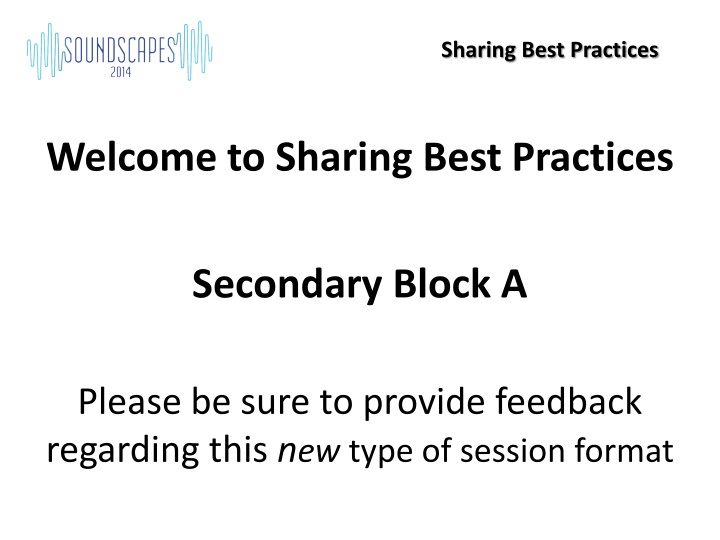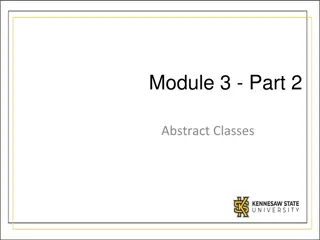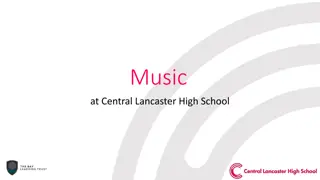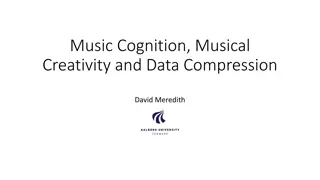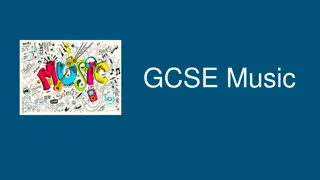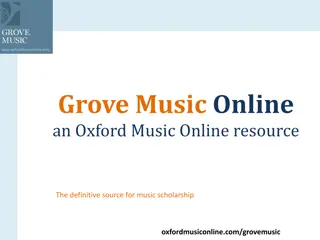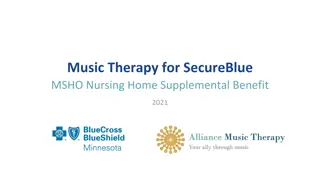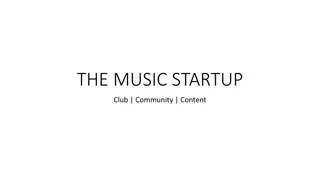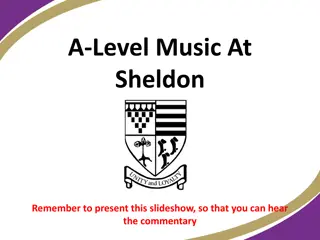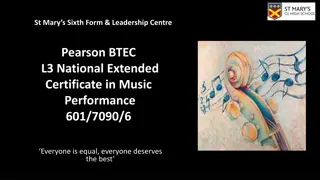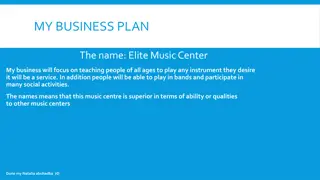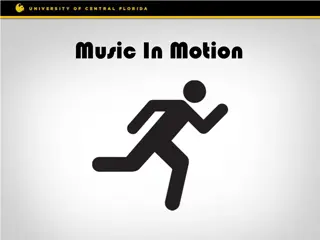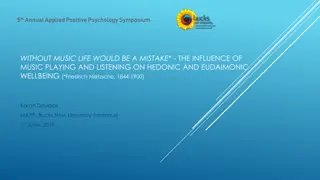Innovative Practices in Special Education Music Classes
Explore a new session format focusing on sharing best practices in special education music classes. From enlisting your EAs to preparing instruments and music sheets, this guide offers alternative notations and creative presentation ideas. Get inspired by practical tips and strategies for engaging students with diverse needs in musical learning and performance.
Download Presentation

Please find below an Image/Link to download the presentation.
The content on the website is provided AS IS for your information and personal use only. It may not be sold, licensed, or shared on other websites without obtaining consent from the author.If you encounter any issues during the download, it is possible that the publisher has removed the file from their server.
You are allowed to download the files provided on this website for personal or commercial use, subject to the condition that they are used lawfully. All files are the property of their respective owners.
The content on the website is provided AS IS for your information and personal use only. It may not be sold, licensed, or shared on other websites without obtaining consent from the author.
E N D
Presentation Transcript
Sharing Best Practices Welcome to Sharing Best Practices Secondary Block A Please be sure to provide feedback regarding this new type of session format
Sharing Best Practices An Alternative to Standard Notation for Special Education Classes Shelly Johnston
Getting Started... Sharing Best Practices 1. Enlist your EAs - Get them on board 2. Poll your students for song choices - What do they want to learn? (You may be suprised!) 3. Prepare your instruments and song sheets 4. Teach/work on the tune 5. Present your Work
Preparing the Instruments Sharing Best Practices What are the needs of your class? What instruments do you have? Using stickers/letters/numbers - figure out what will work with your particular group Some keys will require more than one sticker for the students that are playing chords
Preparing the Music Sharing Best Practices Use a large bold font Include lyrics Make different sheets for melody players and those who will play chords
Present! Sharing Best Practices * Invite guests (kids on spare, another class, administration) in to watch a performance * Play a song in the cafeteria * Make a music video Be Creative!
Sharing Best Practices What s New On The Web & The App Store David Gueulette Ashbury College Ottawa, ON
Practice Centre Sharing Best Practices Gil Estes Cal30 Musical Solutions Uses front facing camera Tuner Timer Metronome Beat patterns
Metronome Plus Sharing Best Practices Designed for the iPhone Tuner Recording Subdivisions Tap entry Currently does not allow for meter and tempo changes
Scale Master Sharing Best Practices Also designed for iPhone Helps students learn scales Also and excellent ear training tool. Moves around the scale pattern in whole or half steps. Does not move by 4ths or fifths.
Sight Reading Factory Sharing Best Practices Subscription based Can be used on any platform (Mac, PC) or device (desktop, laptop, tablet, smart phone) Can create four-part vocal exercises Creates unison exercise for instrumental groups.
Tonal Energy Sharing Best Practices Tuner feature Tone Generator. Sustain feature allows multiple pitches. Analysis feature great for measuring dynamic contrast. Full metronome functions.
Blob Chorus Sharing Best Practices Ear Training App Match the correct blob with King Blob Three to Eight Voices
Sharing Best Practices Tried and True Repertoire Selections for High-School String Ensembles Dr. Andrew Kizas, Director, Regional Strings Program, Port Credit Secondary School, Peel District School Board Presented at OMEA London, ON, Friday, November 7th, 2014
Look fors when choosing string repertoire for students of mixed abilities Sharing Best Practices First and foremost, is it quality music? Will it keep students engaged? What are the technical requirements for each part (e.g., shifting, accidentals, complex articulations, bowings, rhythms etc.)? How long do I have to prepare the students for a performance?
Maintaining Student Engagement Sharing Best Practices Do the first violins get all of the good stuff ? Are the lower strings always in a supportive harmonic role? What are the violas doing in this piece??? :-) Is there room for your advanced students to shine (and not just your advanced violinists)?
Maintaining Student Engagement Will the less-experienced players become overwhelmed? Will the more-experienced players be underwhelmed? Regardless of the level of difficulty, is there compositional substance to the piece? Can I use it to teach form and analysis in a meaningful way to my students?
Teaching Strategies Sharing Best Practices Don t teach the piece from beginning to end. Begin with sections that are immediately accessible, so that you don t lose your less advanced students right from the start. Have your more advanced students model challenging sections, run sectional rehearsals, and provide fingering/bowing suggestions so that they are actively involved in the process as leaders.
Teaching Strategies Sharing Best Practices Do not spend the whole class on the most difficult repertoire, and ensure that you have a variety of repertoire to choose from at all times. Be prepared to make repertoire changes, and have a reading session that allows you to make decisions about your selections. Over prepare and be flexible.
Teaching Strategies Pick repertoire from a diverse range of cultures, genres, periods, and styles. Teach music as cultural practice in everything that you do. Situate music within its larger historical/cultural context on a daily basis.
Sample Repertoire Selections Sharing Best Practices Here is a fantastic selection for a more advanced string group that features a viola, cello, and double bass solo! Dvorak s Finale from Sonatina, Opus 100 (originally for violin and piano). Finale From Dvorak's Sonatina, Opus 100
Sample Repertoire Selections Sharing Best Practices A selection featuring an arrangement of the Allegro from J. C. Bach s Sinfonia No. 6 in G minor. J. C. Bach, Allegro from Sinfonia No. 6 in Minor A less advanced arrangement (technically, but not musically) of the Aria from the Goldberg Variations by J.S. Bach. Aria from the Goldberg Variations
Sample Repertoire Selections Sharing Best Practices Examples of music at the intermediate level that can be used at festivals and showcases at the Board, Provincial, and National levels, and that reflect music from other cultures, include the following: Maharaja Fantasia Espanola
Sample Repertoire Selections Dia de los Muertos Finally, have fun with your selections such as this one titled Rosin Eating Zombies from Outer Space by Richard Meyer. Rosin Eating Zombies from Outer Space! Questions/Comments? THANK YOU!!!
Sharing Best Practices Listen Better, Listen More Lauren Simmons lauren.simmons@TDSB.on.ca Twitter @laurendorphin
Why Listening? Sharing Best Practices Students are already actively engaged in the consumption of music. A passive, non-performance, differentiated way to get students in thinking about music. Breaks up the rhythm of the traditional classroom routine. Touches on student experiences and relates them to traditional/historical material.
Curricular Impetus Sharing Best Practices
Intro: Comparative Listening Sharing Best Practices
Further: Teaching the Elements through Listening Sharing Best Practices Rhythm: sick beat Melody: nice tune Harmony, Dynamics: dramatic role of major/minor, consonant/dissonant in film and video game scores Texture, Form: listen to compare and contrast Timbre: listening for instruments
Further: Teaching the Elements through Listening Sharing Best Practices
Resources Sharing Best Practices Google Drive folder from Momentum 2013 (includes templates and listening lists) Class Blogs: AMI/Band AMM/Music and Computers Rdio Playlists
